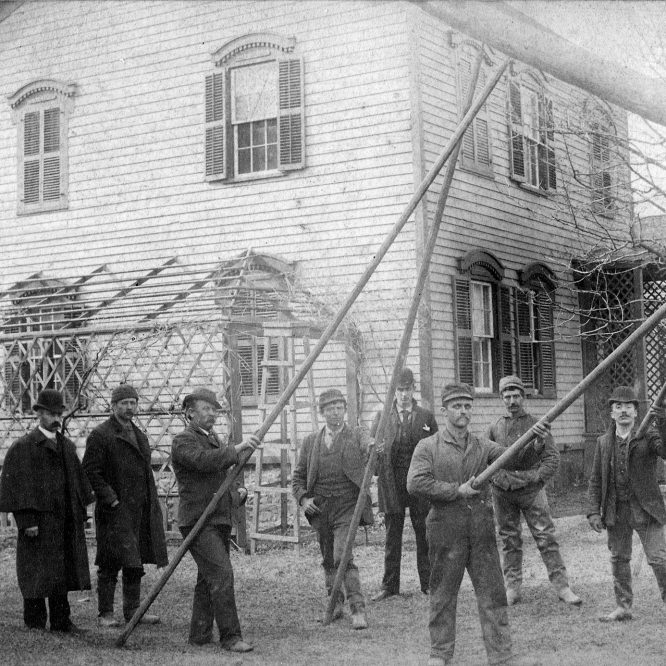
Volume 3, Issue 12
The origins of electric streetlights date back to over 130 years ago when Wabash, Indiana became the first city to utilize the system that would eventually replace gas lighting. It was nearly six years after that initial testing that the Village of Albion began to explore the possibility of erecting electric lights to illuminate the streets. This image shows a group of eleven men erecting the first electric pole in Albion, located on Madison Street (now East Park).
The Albion Electric Light Company, formed in 1889 by E. Kirke Hart, William G. Swan, and George W. Barrell with a capital of $18,000, first proposed the illumination of Albion’s streets at a cost of roughly $55 per light. The first dam was constructed near Sprague’s Mill on East State Street and served as the primary source of local power through the 1890s. Other area municipalities, such as Lockport, started the process of transitioning from gas to electricity but gave up on the endeavor due to excessive costs. Despite the relative increase in costs, Albion’s streets were illuminated by electricity for the first time on April 7, 1890.
The glories of electric lighting were short lived, when the electric company proposed a rate hike for providing service for village lighting. Jumping nearly $20 between 1890 and 1896, the new rate would have led to a $.10 per $1,000 rise in assessments. Naturally the taxpayers voted the proposal down and the electric current was cut. Residents were forced to carry lanterns or wander the streets in the dark.
This raised a huge issue, as the Rochester Democrat and Chronicle noted, because women who paid taxes in the village became extremely vocal about the cutting of electricity. Those who had to walk the streets after dark felt uncomfortable walking late at night. Despite their status as taxpayers, women were still unable to vote at the time. The village later reached an agreement with the company, agreeing to pay the $75 per light and cutting service to seven lights in order to balance the cost.
Two years later, George Lum would assume the lighting contract at a proposed cost of $62 per light, providing service to over fifty streetlights in the village from sundown to 1 o’clock in the morning. The new contract would lead to the construction of a new power plant at Clark’s Mills in Waterport to replace the small plant in Albion.
Of course, electricity was far from safe, often proving dangerous to residents and workers alike. In 1902 a local resident was jolted by electricity while using the phone in their home. It was believed that the electrical line crossed over the phone line causing the shock. Others were less fortunate, such as John Daniels of Albion, who was killed while working for the Buffalo General Electric Company when his shoulder came in contact with live wires. His parents were the first in Albion to receive settlement money as a result of his death under newly passed legislation.
That same year, James Robinson of Albion was killed while working with Matthew Ryan’s quarry outfit. Robinson was electrocuted while moving wires during the process of relocating heavy machinery. The pole he was using came in contact with live wires from Swett’s Electric Light & Power Company where insulation had worn off.

